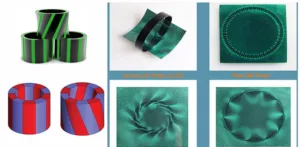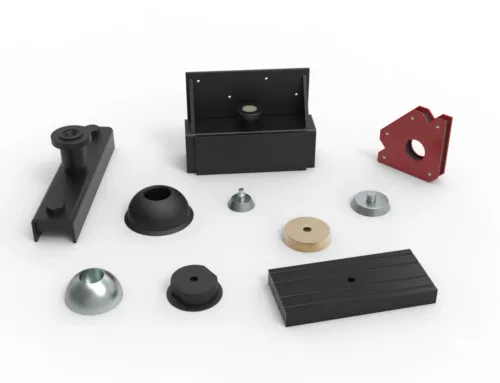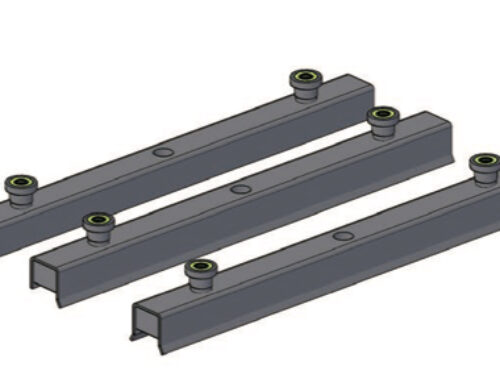Understanding Multi Pole Magnets
Definition and Basic Concept
A multi pole magnet is a magnet designed with several alternating north and south poles arranged closely together. Unlike a traditional magnet, which typically has just one north and one south pole, multi pole magnets create multiple magnetic poles along their surface or volume. This design enhances magnetic performance in many devices.
Difference Between Multi Pole and Traditional Magnets
| Feature | Traditional Magnet | Multi Pole Magnet |
|---|---|---|
| Number of poles | 2 (one north, one south) | Multiple alternating poles (4, 6, 8, or more) |
| Magnetic field pattern | Simple dipole field | Complex field with multiple poles close together |
| Typical applications | Basic magnets, simple compasses | High-performance motors, sensors, and advanced electronics |
| Magnetic force density | Lower | Higher due to pole concentration |
How Magnetic Poles Are Arranged in Multi Pole Magnets
Multi pole magnets arrange poles in various patterns depending on the application:
- Radial arrangement: Poles alternate around a circular surface, useful in rotating devices.
- Axial arrangement: Poles alternate along the magnet’s axis in a linear fashion.
- Halbach arrays: A special arrangement that enhances magnetic field strength on one side while canceling it on the other.
Magnetic Field Distribution and Pole Orientation
In multi pole magnets, the magnetic field is distributed with alternating directions closely spaced. This creates a dense field with sharp changes in polarity, providing:
- Increased force over a smaller area
- Better control over magnetic interactions
- Reduced magnetic interference away from the target area
Visual idea:
| Pole Type | Direction | Field Effect |
|---|---|---|
| North (N) | Outward magnetic flux | Push/pull forces in devices |
| South (S) | Inward magnetic flux | Completes magnetic circuit with adjacent poles |
Types of Multi Pole Magnets

Multi pole magnets come in several types, each designed for specific magnetic field patterns and applications.
Radial Multi Pole Magnets
These magnets have poles arranged around the circumference of a cylinder, creating a magnetic field that points radially outward or inward. They’re commonly used in electric motors, especially in multi pole magnetic rotors, since they provide strong torque and smooth rotation.
Axial Multi Pole Magnets
In axial designs, the poles are stacked along the magnet’s central axis. This setup produces magnetic fields along the axis, making them ideal for sensors and encoders where precise magnetic field control is needed.
Halbach Arrays and Their Significance
Halbach arrays are special multi pole magnets arranged to concentrate the magnetic field on one side while canceling it on the opposite side. This unique property improves efficiency and reduces stray fields, which is especially useful in applications like brushless motors and magnetic bearings.
Material Variations and Their Effects
The choice of material impacts the design and performance of multi pole magnets:
- Neodymium (NdFeB): Strongest magnetic force, lightweight, ideal for compact, high-performance motors.
- Ferrite: More affordable and corrosion-resistant but with lower magnetic strength, suited for cost-sensitive applications.
- Samarium Cobalt (SmCo): High-temperature resistance and stable performance, perfect for harsh environments and high-reliability equipment.
Choosing the right material helps optimize the magnet’s magnetic field distribution and overall efficiency in your application.
Manufacturing Process of Multi Pole Magnets
Producing multi pole magnets involves specialized methods to ensure the magnetic poles are accurately formed and aligned. The process typically starts with selecting the right magnetic material—commonly neodymium, ferrite, or SmCo—based on the intended application.
Production Methods
Common manufacturing techniques include:
- Sintering: Powders of magnetic materials are compressed and heated to form a solid magnet. This is ideal for high-strength magnets like neodymium.
- Bonded magnet molding: Magnetic powders mixed with binders are shaped into complex forms using injection or compression molding. This method allows more flexible shapes but usually has lower magnetic strength.
- Hot pressing: High temperature and pressure are applied to align the magnetic grains, improving magnetic performance, especially in SmCo magnets.
Magnetization Techniques for Multi Pole Magnets
The key to multi pole magnet performance is precise magnetization, done using custom-made magnetizing fixtures or magnetizers. These tools apply strong magnetic fields in specific patterns to create the multiple magnetic poles.
- Pulsed magnetization is often used to ensure each pole has the correct strength and orientation.
- For high pole counts, step-wise or segmented magnetizing is necessary to avoid pole overlap.
Precision Machining and Quality Control
Once magnetized, magnets often require precision machining to achieve exact dimensions and smooth pole transitions. CNC machining is common to maintain tight tolerances critical for motors and sensors.
Quality control is thorough and includes:
- Magnetic field mapping to verify pole distribution and strength.
- Dimensional checks to ensure fit and function.
- Demagnetization testing to confirm stability.
Challenges in High Pole Count Magnet Production
Manufacturing magnets with many poles presents unique difficulties:
- Accurate pole orientation becomes harder as pole count increases.
- Maintaining consistent magnetic strength across all poles is challenging.
- Machining thin, complex shapes without cracking or chipping is demanding.
- Higher production costs and longer lead times due to increased complexity.
Despite these challenges, advances in materials and magnetizing equipment allow reliable, high-performance multi pole magnets suited for brushless motors, sensors, and other precision applications.
For more on magnet materials and manufacturing, check out our magnets material resource.
Applications of Multi Pole Magnets
Multi pole magnets play a key role in a variety of industries, especially in electric motors and generators. They’re widely used in brushless DC motors, where multiple magnetic poles improve efficiency, boost torque, and allow for smoother operation. This makes them popular in everything from electric vehicles to household appliances.
Another big use is in magnetic sensors and encoders. Multi pole magnets help these devices detect precise position and speed, which is critical for automation and control systems.
In magnetic couplings and brakes, multi pole designs offer reliable, contactless power transfer and controlled stopping power. This reduces wear and maintenance needs.
Renewable energy systems also benefit. Wind turbines often use multi pole magnetic rotors to maximize power output while minimizing size and weight.
Finally, industrial automation and robotics rely on multi pole magnets to deliver precise motion control and improve machine performance. Whether it’s robotic arms or conveyor systems, these magnets help keep things efficient and accurate.
Advantages of Using Multi Pole Magnets

Multi pole magnets offer several clear benefits that make them ideal for a wide range of applications, especially in the U.S. market where efficiency and performance matter.
-
Increased Magnetic Force Density and Efficiency
Multi pole magnets pack more magnetic poles into the same space, which means stronger and more focused magnetic fields. This leads to higher efficiency in devices like motors and generators, saving energy and boosting output.
-
Improved Torque and Performance in Rotating Machinery
With more poles interacting in a magnetic rotor, machines get smoother and more powerful torque delivery. This is especially valuable in brushless DC motors, where consistent torque improves overall machine reliability and performance.
-
Compact Design Benefits
Because multi pole magnets manage to fit multiple magnetic poles in a smaller footprint, you can build smaller, lighter devices without sacrificing power. This is critical for applications where space and weight are limited.
-
Reduced Cogging Torque in Motors
Cogging torque causes jerky motion in motors. Multi pole magnet designs help minimize this issue by providing a more continuous magnetic pull, resulting in smoother motor startups and quieter operation.
-
Enhanced Control in Precision Instruments
Devices that rely on precise magnetic positioning, like magnetic sensors and encoders, benefit from the sharp, well-defined poles of multi pole magnets. This translates to higher accuracy and better control in industrial automation and robotics.
Choosing the right multi pole magnet can significantly boost machine efficiency and reliability, making them a smart choice across many industries. For more insights on efficient magnet designs, check out NBAEM’s guides on new magnetic technologies for NdFeB magnets.
Choosing the Right Multi Pole Magnet for Your Needs
Picking the right multi pole magnet means looking at several key factors to ensure it fits your application perfectly:
- Pole Count: More poles can improve performance in motors and sensors but may increase complexity and cost.
- Magnet Size: Size impacts the magnetic force and how compact your design can be.
- Material: Common choices include neodymium, ferrite, and samarium cobalt—all with different strengths and temperature resistances. For instance, neodymium multi pole magnets offer strong magnetic force but may need coatings for corrosion protection.
- Operating Environment: Consider temperature, humidity, and exposure to chemicals since these affect magnet durability and performance.
At NBAEM, we offer extensive customization options tailored to your design needs. Whether you require specific pole patterns, sizes, or magnet materials, NBAEM works closely with clients on OEM and ODM projects to deliver precision-engineered solutions. This ensures that your multi pole magnet performs reliably in its intended application.
For detailed insights on magnet materials, check out our resource on Samarium Cobalt magnets.
FAQs About Multi Pole Magnets

What factors influence the number of poles
The number of poles in a multi pole magnet mainly depends on the application and desired performance. Higher pole counts are common in motors requiring smoother operation and better torque control, like brushless DC motors. Design constraints such as magnet size, material properties, and manufacturing capabilities also affect pole count.
How do multi pole magnets affect motor performance
Multi pole magnets improve motor efficiency by providing higher torque density and reducing cogging torque, which results in smoother rotation. More poles allow for better magnetic field control, enhancing overall motor responsiveness and performance. This is especially useful in precision applications like robotics and electric vehicles.
Can multi pole magnets be demagnetized easily
Generally, multi pole magnets made from strong materials like neodymium are resistant to demagnetization. However, exposure to high temperatures, strong opposing magnetic fields, or physical damage can weaken them. Proper handling and operating conditions help maintain their magnetization.
What maintenance is needed for these magnets
Multi pole magnets require minimal maintenance but should be kept clean and free from corrosion. Check for physical damage regularly, especially in harsh environments. Using protective coatings or housings can extend their lifespan. Avoid overheating or exposing them to strong external magnets to preserve magnetic strength.
Why Choose NBAEM for Multi Pole Magnets
NBAEM stands out as a trusted Chinese supplier of multi pole magnets, known for delivering high-quality magnetic materials tailored to the needs of the U.S. market. With years of experience, NBAEM combines advanced manufacturing techniques and strong R&D to ensure each product offers superior performance and reliability.
Commitment to Quality, Customization, and Innovation
- Precision Manufacturing: NBAEM uses state-of-the-art processes to produce consistent, high-pole count magnets with exacting tolerances.
- Custom Solutions: Whether you need radial multi pole magnets or specialized Halbach arrays, NBAEM supports flexible designs and materials to fit your specifications.
- Innovation Focus: Constant R&D efforts keep NBAEM at the forefront of magnet technology, improving efficiency, magnetic strength, and thermal stability.
Key Certifications and Compliance
NBAEM adheres to international quality standards including ISO certifications and environmental regulations, ensuring their multi pole magnets meet industry expectations for durability and safety.
| Certification Type | Description |
|---|---|
| ISO 9001 | Quality Management System |
| RoHS Compliance | Restriction of hazardous substances |
| REACH | Chemical safety standards |
Proven Success in Projects
NBAEM’s multi pole magnets have been integral in projects ranging from brushless DC motors to advanced renewable energy systems. Their expertise helps OEMs and ODMs accelerate production while maintaining high standards.
- Electric Motors: Multi pole magnetic rotors that enhance torque and efficiency.
- Wind Turbines: Custom NdFeB multi pole magnets that perform well under harsh conditions (NdFeB Magnets for Wind Turbines).
- Industrial Sensors: Precise magnetic patterns for sensor applications (Magnetic Sensor Technologies).





Leave A Comment